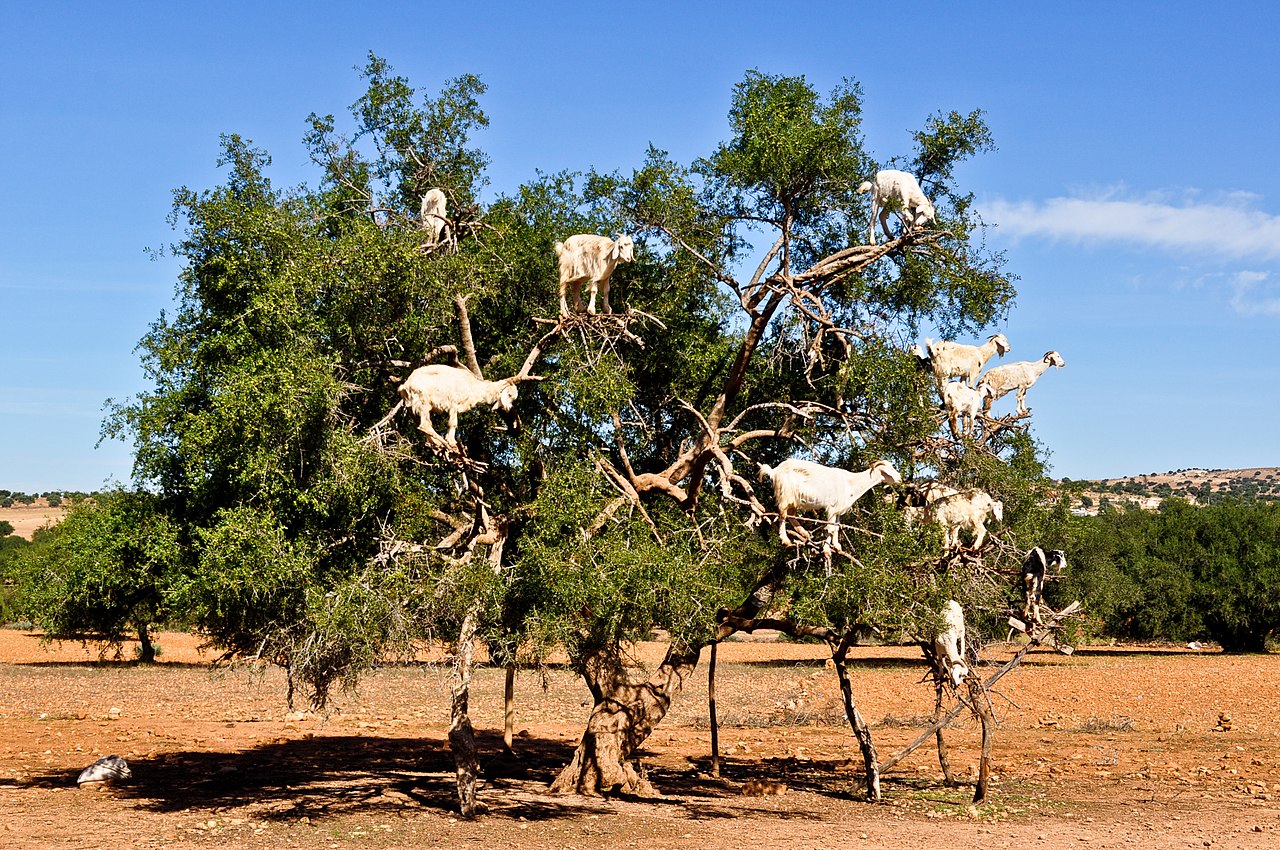Spidergoats!
Not actual spidergoats. Just some Moroccan goats in a tree
What’s stronger than steel, tougher than bulletproof Kevlar, can withstand temperatures ranging from 200 Celsius down to minus forty, can stretch up to five times its length without breaking, and is made by squeezing goop out of an arachnid’s backside?
The answer is, of course, spider silk – one of the most remarkable substances produced by a living organism that we know of. It’s also a fibre that humans have been exploiting for thousands of years, from Aboriginal fishing lines and Pacific islanders’ nets to crosshairs in telescopes and gun sights in more recent years.
Spider silk’s naturally antimicrobial and hypoallergenic characteristics have also seen it put to good use in medicine – as Roman author Pliny the Elder noted, “For a cobweb astringeth, refrigerateth, solderth, joyneth together . . . not suffering rotten or filthy material to remain,” and cobwebs were often used as bandages in the ancient world.
An old Chinese remedy also suggests that a cobweb placed secretly beneath the collar on the 7th day of the 7th month will cure forgetfulness and dull mental conditions, although I’m less convinced by the evidence base for that one.
But it’s spider silk’s physical properties as well as its medicinal benefits that are getting researchers excited, with potential uses including lightweight, waterproof and even bulletproof clothing, ropes, nets, sails and parachutes, bandages and all sorts of other biomedical devices.
Unfortunately, it’s very difficult to farm spiders and make them produce webs to order – not helped by the fact that good silk spinners like golden orb spiders have the annoying tendency of wanting to bite each other’s heads off if they’re kept in captivity together.
And although it is possible to ‘milk’ the silk from a spider, it’s certainly not an easy job. French entomologist René Antoine Ferchault de Réaumur was the first person known to have given it a go back in 1709, collecting silk from egg sacs in an attempt to make stockings and gloves.
Three hundred years later a team of 70 people spent four years making an 11-by-4-foot fabric from silk extracted from more than a million golden orb spiders in Madagascar.
Spider silk jacket
I do recommend taking a look at the article in Wired about how this was done, from designing a replica 19th century spider milking machine to extract the silk from the spiders to the challenge of finding enough willing volunteers to collect a million wild arachnids and attach them to the device, especially because the spiders like to bite!
Rather than ever larger banks of spider milking machines, the solution to mass-produced spider silk lies in genetic engineering. The key components of spider silk are spidroin proteins, encoded by (unsurprisingly) spidroin genes. The first Spidroin gene, Spidroin I, was identified in 1990, with Spidroin II following two years later, both from an American species of golden orb-weaver called Nephila clavipes, also known as the banana spider.
And now we know the sequences of the spider silk genes, researchers can put them to work, using genetic engineering techniques to insert Spidroin genes into more biddable organisms that will churn out silk proteins to order. One idea is to produce Spidroin in E. coli bacteria, which can be easily grown grown up in bulk in the lab. But Spidroins are large repetitive proteins, which makes them tricky for the bugs to manufacture.
Other labs worked on getting Spidroin genes into tobacco and potato plants that produce Spidroins, but by far the most fantastic idea came from University of Wyoming professor Randy Lewis. In 2011, he announced that he had managed to put Spidroin genes into a female goat, Freckles, so she would produce silk proteins in her milk.
Sadly, this spidergoat couldn’t spin webs or scale buildings like Spiderman, but she did spark a huge amount of interest in the possibility of large-scale silk farming. Lewis trademarked his resulting silk, which he called Biosteel, and set up a company – Nexia Biotechnologies – to exploit the idea. Lewis now maintains a breeding colony of around 30 spidergoats at his new lab at Utah State University.
Further reading and references:
1 million spiders make golden silk for rare cloth – Hadley Leggett, Wired
Oh what a tangled web! The medicinal uses of spider silk – James Newman and Catherine Newman
The tangled history of weaving with spider silk – Amelia Soth, JSTOR
11 surprising historical items that were created using spider silk – Rachel Souerbry
Synthetic biology and the rise of spidergoats – Adam Rutherford, Guardian
The Silk Route – David Butler, The Biologist
Photos: Spider silk fabric Cmglee, via Wikimedia Commons, CC-BY-SA 3.0; Goats in an Argan tree, Morocco, Elena Tatiana Chris, via Wikimedia Commons, CC-BY-SA 4.0




